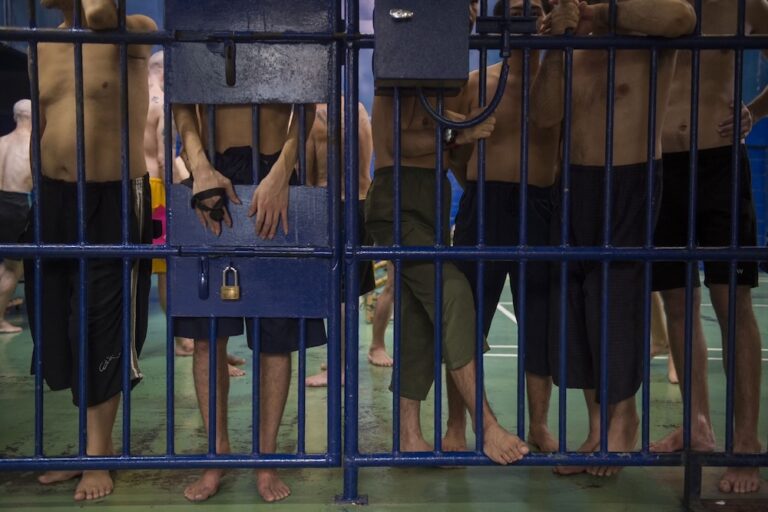(CPJ/IFEX) – The following is a CPJ press release: FOR IMMEDIATE RELEASE 33 JOURNALISTS KILLED IN 1999 BECAUSE OF THEIR WORK CPJ Sees Worldwide Trend to Silence Witnesses to Wars, Atrocities, Corruption Sierra Leone Tops List with Ten Killed; Journalists Also Killed in Yugoslavia, Colombia, Chechnya, East Timor, and Other Countries Warring factions, seeking to […]
(CPJ/IFEX) – The following is a CPJ press release:
FOR IMMEDIATE RELEASE
33 JOURNALISTS KILLED IN 1999 BECAUSE OF THEIR WORK
CPJ Sees Worldwide Trend to Silence Witnesses to Wars, Atrocities, Corruption
Sierra Leone Tops List with Ten Killed;
Journalists Also Killed in Yugoslavia, Colombia, Chechnya, East Timor, and Other Countries
Warring factions, seeking to silence witnesses, made journalists special targets for assassination in 1999, when a total of 33 journalists were killed because of their work, according to the Committee to Protect Journalists. Some were shot in cold blood while going about their daily routines; one was killed along with his family when rebels surrounded his house and set it afire; others were caught in crossfire or bombings, or shot by snipers in regions of the world where conflict rages.
Sierra Leone was the deadliest country for journalists. CPJ documents 10 killed there last year, most by rebels who in some cases conducted house-to-house hunts for reporters whose work was deemed “anti-rebel.”
Other journalists were killed reporting on violent conflicts in Yugoslavia, Colombia, East Timor and Chechnya. In many cases they were deliberately targeted by warring factions.
“We see a clear policy, particularly in Sierra Leone, Colombia and East Timor, of armed factions seeking to banish or even exterminate journalists in order to hide the truth,” said CPJ executive director Ann Cooper. “Whether it’s the Indonesian army or Sierra Leonean rebels, the goal is obvious: get rid of the witnesses whose reporting can inform the world about atrocities, corruption, or killings.”
Deaths Increase by One Third Over Last Year
In 1998, CPJ confirmed the killing of 24 journalists in 17 countries. This year’s tally of 33 journalists, killed in 10 countries, marks an increase of one third.
Journalists died in several countries where violent conflicts rage, either as victims of assassinations, or because their work put them in the line of fire. Six lost their lives in Yugoslavia: three killed in a NATO bombing, two hit by sniper fire, and one, a newspaper publisher, apparently assassinated in cold blood for his outspoken criticism of President Slobodan Milosevic. Of the four journalists who died in Colombia, three were likely targeted by right-wing factions in the violence that has torn that country apart for decades, and one cameraman died during a guerrilla attack.
The following list is a brief summary of the circumstances surrounding the deaths of each of the journalists. More detailed accounts are available on CPJ’s website: http://www.cpj.org. Click on “Journalists Killed in 1999.”
CPJ continues to investigate the cases of 19 other killed journalists whose deaths may have been related to their professional work.
Journalists Killed in 1999
ARGENTINA: 1
Ricardo Gangeme, the 56-year old editor and publisher of a weekly magazine in Trelew, Argentina, was shot in the head on May 13 by a man who fled on foot. Gangeme’s scathing reports on local corruption had earned him many enemies.
COLOMBIA: 4
On August 13, two men on a motorcycle intercepted the jeep driven by Colombian political satirist Jaime Garzon, shooting him repeatedly in the head and chest. Garzon, one of the best known radio personalities in Colombia, had been threatened by Carlos Castaño, the leader of a right-wing paramilitary organization. But it remains unclear who ordered the killing.
On October 21, radio reporter Rodolfo Julio Torres was abducted from his home near Cartagena, murdered, and dumped on the side of the road. Torres had been threatened in a pamphlet thought to have been written by Carlos Castano’s right-wing paramilitary organization, the United Self Defense Forces of Colombia (AUC).
Gunmen on a motorcycle killed Gúzman Quintero Torres on September 16, in the violence-plagued city of Valledupar. Quintero, the editor of a daily newspaper called El Pilon, had covered AUC activities in the region.
Pablo Emilio Medina Motta, a cameraman, was shot and killed December 4 while covering a guerrilla attack in Huila Department. He had jumped on the back of a motorcycle driven by a police commander to get a better view of the action.
EAST TIMOR: 2
Agus Muliawan, a reporter for the Tokyo-based news agency Asia Press International, was among a group of nine church workers massacred on Saturday, September 25, as they traveled to Baucau from Lospalos, East Timor. The gunmen were identified as Indonesian troops.
The body of Sander Thoenes, 30, a Dutch freelance reporter, was found on September 22 in the Dili suburb of Becora. Investigators believe that he was murdered by members of the same Indonesian army battalion that killed Agus Muliawan.
LEBANON: 1
Ilan Roeh, a reporter with Israel Radio, was killed February 28 when a roadside bomb exploded in Israeli-occupied south Lebanon. Roeh was traveling in an Israeli military convoy when the bomb went off.
NIGERIA: 3
Photojournalist Samson Boyi was killed November 5 when armed men attacked the convoy of Adamawa state governor Haruna Bonnie. Boyi was on assignment to cover Bonnie on a trip to the town of Bauchi.
Freelance journalist Fidelis Ikwuebe was abducted and murdered on April 18. According to local journalists, Ikwuebe was on assignment, covering violent clashes between the Aguleri and Umuleri communities in Anambra state.
Local journalists reported the killing of Sam Nimfa-Jan, of Details magazine, on May 27 in Kafanchan, Kaduna state. Nimfa-Jan was on assignment, covering riots between the Hausa Fulani and the Zangon-Kataf groups.
RUSSIA: 3
After several Russian rockets hit a crowded outdoor market in central Grozny on October 27, Supian Ependiyev of the independent Chechnya weekly Groznenskiy Rabochiy went to cover the carnage. As Ependiyev was leaving the market area, a new round of rockets fell. He died of shrapnel wounds the next day.
Cameramen Ramzan Mezhidov and Shamil Gigayev were killed while following a refugee convoy fleeing Chechnya on October 29. After Russian rockets hit a busload of refugees, the two cameramen went to film the aftermath. They were killed when another rocket hit the convoy.
SIERRA LEONE: 10
James Ogogo, a Nigerian journalist for the independent Concord Times, was murdered by Revolutionary United Front (RUF) rebels in Freetown on January 8. An eyewitness reported that a group of rebels sought out Ogogo at the newspaper’s offices, tied him to a truck and dragged him along the road. They then stopped the truck, untied Ogogo, and told him to start walking. Then they opened fire and killed him.
RUF rebels abducted radio journalist Jenner “J.C.” Cole from his Freetown home on January 9. He was shot dead by his abductors, in front of his fiancée. RUF forces reportedly entered Freetown with a list of journalists to be eliminated for what was perceived as “anti-RUF” coverage.
Freelance reporter Mabay Kamara was abducted by RUF rebels January 9 and subsequently murdered. Kamara’s wife witnessed the abduction. Rebels set the Kamara residence on fire before leaving the area.
Radio correspondent Mohammed Kamara was shot dead by RUF rebels in Freetown January 9. Kamara covered court proceedings, including the treason trials that followed President Kabbah’s reinstatement to power after a period when Sierra Leone was ruled by rebel factions.
Editor Paul Mansaray, his wife, their two young children, and a nephew were murdered January 9 by RUF rebels at their home east of Freetown. Rebels set the house ablaze and fired their weapons into the house as it burned, with Mansaray and his family inside.
Myles Tierney, a Nairobi-based producer for Associated Press Television News (APTV), was killed January 10 in Freetown when his vehicle was sprayed with bullets by a man reported to be an RUF rebel. A West African peacekeeping force (ECOMOG) soldier was in the vehicle when the armed man approached it, exchanged words with the soldier, and opened fire with a semi-automatic rifle.
Munir Turay, a freelance reporter, was killed sometime between January 9 and January 15. Colleagues who attended his funeral reported that he had bullet holes in his back. At that time rebel forces were systematically murdering journalists, and Turay’s colleagues were in no doubt that he had been killed for this reason.
A group of rebels from the RUF and the former Armed Forces Revolutionary Council (AFRC) killed Alpha Amadu Bah, a sports reporter for the daily Independent Observer, at his home in Freetown. According to an eyewitness, the rebels came to Bah’s house January 17 asking for a different person, then set the house on fire and shot Amadu Bah dead as he was trying to flee.
Abdulai Jumah Jalloh was news editor of the independent newspaper African Champion. He was killed February 3 by a West African peacekeeping force (ECOMOG) soldier in Freetown, reportedly because he was accused of being an RUF rebel.
Conrad Roy, former news editor of the banned Expo Times newspaper, died April 30 after contracting tuberculosis in Freetown’s central prison. Roy received no medical treatment until April 26, four days before his death in the Lakka TB Hospital.
SRI LANKA: 2
Two Sri Lankan broadcast journalists, Indika Pathinivasan and Anura Priyantha, were among 22 people killed in a December 18 assassination attempt against President Chandrika Kumaratunga at an election rally in Colombo. According to press reports, a suicide bomber detonated the bomb.
TURKEY:1
Ahmet Taner Kislali, a columnist for the daily Cumhuriyet, was pronounced dead on arrival at a local hospital October 21, after reportedly sustaining shrapnel wounds to his face and chest from a bomb. Press reports, citing Turkish officials, said that the bomb was wrapped in newspaper and placed on the windshield of Kislali’s car.
YUGOSLAVIA: 6
Independent Belgrade publisher Slavko Curuvija died April 11 in what appeared to be a professional assassination. His wife, who was also attacked, said two gunmen fired several bullets into her husband’s back and head as they walked outside their home. Shortly before his murder, state television broadcast accusations against Curuvija, alleging that he supported NATO’s attack on Yugoslavia.
Shao Yunhuan, Xinhua News Agency; and Xu Xinghu and Zhu Ying, The Guangming Daily, all Chinese nationals, were on assignment in Belgrade to report on the war between NATO and Serbian forces. They were killed May 8 when NATO bombs hit the Chinese Embassy, where the journalists were staying.
Volker Kraemer and Gabriel Gruener of the German magazine Stern were on assignment in Kosovo June 13, when they encountered sniper fire outside Dulje, 25 miles south of Pristina. Kraemer was killed instantly by a shot to the head; Groener was hit in the abdomen and died in a helicopter while en route to a hospital in Macedonia.
Documenting the Deaths
CPJ applies stringent guidelines and thorough journalistic standards to track cases of journalists killed on assignment or as a direct result of their professional work. By publicizing and protesting these killings, CPJ hopes to help change the conditions that foster violence against journalists. The death toll that CPJ compiles each year is one of the most widely cited measures of press freedom in the world.
The Committee to Protect Journalists is a nonpartisan, nonprofit organization dedicated to the defense of press freedom everywhere.


